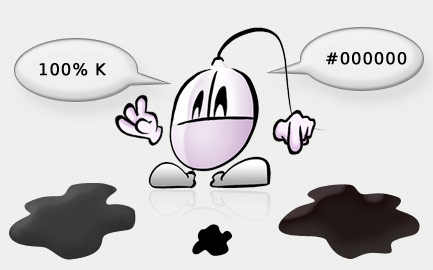Pure 100% CMYK black is different from rich black (HTML #000000 color code)

Did you know that 100% CMYK black is NOT the same as HTML #000000 color?
In most traditional CMYK print oriented programs, the default black color is the so called pure black (or solid black), composed of 0% of CMY inks, and a 100% K.
Nevertheless, if we choose the HTML #000000 black color code, we are choosing a rich black color (also called jet black, or even superblack). This rich black color is an ink combination of the following ink percents:
- Cyan: 86%
- Magenta: 85%
- Yellow: 79%
- Black: 100%
At least, these are the values of the rich black color in Adobe Illustrator. Nevertheless, these CMYK ink percents may vary for the rich black color in other programs.
Do rich black and #000000 black look like real black?
The problem with pure black (100 K) is that, when it is depicted in some RGB color space, it will look like a dark grey color.
On the other hand, the darker than black (on a computer screen) rich black color would look like a dark brown color in CMYK, as it depends a lot on the actual inks used by each printer.
In fact, this makes sense: in a CMY substractive color mixture the darker color possible would look like a dark brownish color.
On the other hand, a single black ink cannot absorb any color radiation in real world (and thus being actually pure black), so it looks like some kind of dark gray.
Finally, the misleading of the printing plates may add some color halos to a 100 K print on a colored background. This wouldn't happen using rich black instead of pure black.
What to use, 100% black in CMYK or rich black in HTML (#000000)?
Working with CMYK blacks and RGB blacks is very easy if you take into account these 2 main points:
- Don't use CMYK rich black on a traditional CMYK print. Even with a more dense ink pattern, the result won't look as a pure clean black color in CMYK printing. You would be printing a dark brown or dirty dark grey instead of black. So printing black CMYK requires you to use only 100% Black.
- Use the HTML #000000 color when exporting RGB images. A 100% K value would look like a dark grey in a computer screen, so you need to use rich black to see true RGB black in your monitor.
So stay clear of rich black in most traditional CMYK printing processes that use a white background. You would only need to use rich black if you try to print black text over an image or picture, to prevent trapping problems (color halos that surround the black) that would make the text hard to read.
Adobe Illustrator rich black tricks
In Adobe Illustrator there is a little trick to make your life easier. It allows you to work always with pure black (100% Black, the default black color in Illustrator color swatches), even when exporting your image to RGB: make sure that Edit > Settings > Appearance of Black is configured this way:
- Displaying all black colors on screen as rich black. So you won't be confused with dark grey previews of your 100% K black.
- Exporting and printing CMYK blacks as rich black. This does not change the black color (that remains as 100 K with no brownish color mixtures), but will create the #000000 HTML superblack color if exported to RGB color spaces.
We hope that this will shed some light telling the differences between pure 100% CMYK black and the rich black HTML #000000 color code!
 Stumble
Stumble
3 comments:
The mix of "rich black" should really depend on the total ink weight of the paper you're using to print and the process. For instance if you were to use the colors for "rich black" on newsprint, you would exceed the amount of ink the paper could absorb.
It's a good point, as depending on the printing technique, the way in which the colors are combined greatly varies.
This article was mostly focused on surfaces which support high quality CMYK digital offset printing at 300 dpi.
I have successfully used 30, 30, 30, 100 (CMYK) as "rich black" on both print press and in digital copiers to achieve a very smooth, satin black "finish".
Post a Comment